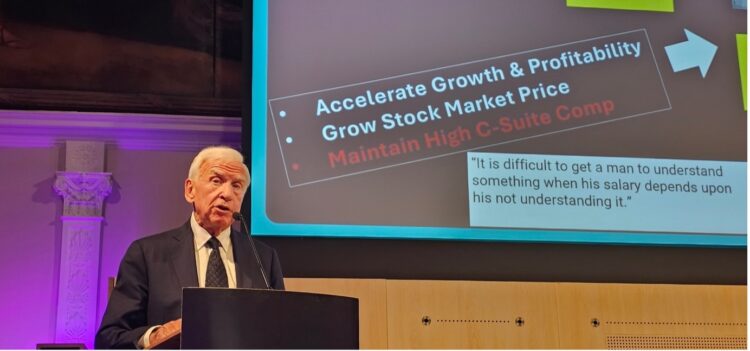The future of advertising: reasons to be cheerful… but realistic

Opinion
Media is now funded by divergent groups of big and small advertisers. There’s no going back, but we need to build an industry where all are united by making their advertising work harder and being sensitive to how they do it.
Autumn is the time for some great advertising thinking to appear.
Whether it’s The Future of Media events in London and Manchester, System1’s ‘Creative Consistency’ work, the IPA Effectiveness papers, Profit Ability 2 from Thinkbox, pretty much everything from WARC, the combined output of the venerable ‘Attention’ community; A Year of Creativity from Sue Unerman and Kathryn Jacob; and the launch of Isba’s cross-media measurement platform Origin….
…there are indeed a lot of ‘clever bastards’ out there and we should treasure them all.
What’s next though?
Great thinking was on show too at our kick-off meeting for ‘Advertising : Who Cares?’ (AWC) last month.
Dozens of people were involved voluntarily, both on stage and behind the scenes. The effort was monumental and the feedback extraordinary and encouraging.
We had great sessions on the value of Creativity; the need for Transparency and Trust; the truth behind today’s Business Models; the latest news from the frontline of people’s attitudes towards advertising as a career; the dos and don’ts of Accountability and Measurement; the importance of advertiser support for strong journalism and quite a lot of fun. Denise Turner’s team bravely attempted to show how difficult making measurement interesting can be.
And Sir John Hegarty and David Wheldon reliably provided a dose of wisdom and commonsense and all of this was presided over by Stevie Spring in her magisterial way.
So thoughts turn to “what’s next?” We have ideas on this.
One over-riding theme is the inter-connectedness of these topics (and others).
There is a common thread to a world where creativity is in decline, effectiveness has waned and trust has receded; people trust advertising less than before (notwithstanding a recent rally) and trust between advertisers and their commercial partners has plummeted.
The causes of much of this were evident from Michael Farmer’s address (pictured, below) on some of the business models that lie behind today’s advertising ecosystem.
Farmer brilliantly demonstrated the cascading effect of the incentive systems that have effectively conspired to make advertising less effective at driving growth. In the process much of the art of advertising success has been sacrificed at the altar of apparent efficiency.

This theme of inter-connectedness is key to the next steps in the AWC movement and, having assessed feedback among our 450+ supporters to our working sessions (all available on YouTube), we now have an approach that we are discussing with them.
Tech dominance is only getting stronger
Another principle we are working towards is to be utterly realistic about trends in our industry.
All of the great work described above is of great value but has to apply to the truth of today’s communications market.
The present-day tide favours more direct modes of advertising that are powered by first party data and Advertising Intelligence. The rise and rise of retail media, digital commerce and connected TV (especially YouTube) is phenomenal.
We are not short of data to tell us which way the wind is blowing. Warc report that the total ad market has doubled over the last decade and at a rate that is 2.8 times faster than economic output. Warc estimates that Meta, Amazon and Alphabet account for over 70% of all incremental spend during that period and will account for over 44% of the global market this year, which will beat $1tn for the first time.
Conversely, the traditional ad-funded players are losing out.
Last week Channel 4 reported a 10% decline in total revenue in 2023 as the upswing in digital revenues only partially offset a 16% reduction in linear. The picture is similar throughout the world as traditional TV companies evolve to position themselves as accelerators of a more performance-led advertising model.
The former mode of brand-led advertising is waning as the new modes of business-building proliferate. This reinforces the hold that the big Silicon Valley players have had on the ad industry for several years now, and Netflix, Amazon Prime, Disney+ and FAST streamers are eating away at the TV pie. The dominance of the big online publisher/broadcasters has advanced strongly this year.
For many advertisers, significant business can be built without the traditional ways to build a brand, as evidenced by companies such as Applied Nutrition. Taken together, smaller businesses provide a lot of the fuel for search and social channels which adds up to a much larger advertising industry.
But, with declining audiences for mainstream media, big brands feel they need to compete for audience in the newer channels.
This leads to a free-for-all where everyone, large or small, is jostling for attention.
Risks galore in a ‘full funnel’ world
Yet it is clear that the direction of travel is towards more performance-led.
First-party led channels that are closer to the transaction and becoming increasingly ‘shoppable’. The old definitions of ‘brand’ and ‘performance’ are less relevant now. People talk about ‘full funnel’ but often start at the bottom.
The tide is going in this direction but there are risks galore for all advertisers amid the natural seduction of media that are in theory more targeted and responsive.
A particularly acute article by tech journalist James Ball for Prospect doesn’t pull its punches.
“Automated systems generate fake but clickable content. Bot accounts like and comment, boosting the slop in the algorithms of social media sites and search engines. Clickfarms monetise the whole endeavour, posing as real users with real eyeballs and thus earning advertising revenue. In this way, the web is being taken over by a global, autiomated sad fraud system, and whether or not any human sees any of it is entirely irrelevant”.
And that’s just click fraud. Impression fraud is a much bigger problem in the Open Web than we like to pretend (even if some inroads are being made). Overall Ad fraud is a bigger problem than our industry pretends, and Connected TV is badly affected, as Dave Morgan has reliably pointed out.
But ad fraud is only one part of the egregious inefficiency of the Open Web in particular.
As new channels achieve great success in attracting ad revenue, the robbers are always ahead of the cops. As the7stars’ Jenny Biggam said at AWC, it is galling to see advertisers losing billions in fraud and other inefficiencies while squeezing their agencies on fees for a fraction of the amount. Make that make sense.
Online advertising channels are even more in the ascendancy and the risk of leakage is correspondingly high.
One popular option is to simply throw lots of content at multiple channels on the basis that something will get through (a bit like human reproduction).
This is where we are today: Advertisers are overwhelmed by content and channel choice and their measurement, so they simply throw it out there. Thousands of ads are loaded onto hundreds of thousands of websites and apps (about 44,000 per campaign in the ANA’s Open-Web programmatic study) in the hope that some of it will ‘work’.
As Farmer described, creative agencies are becoming factories of content where volume, not value, is king.
The advertising industry is no longer a singular entity. Our world has splintered.
Some advertisers still see value in building their brand and take a longer-term perspective, while the long tail of smaller players do not share that view. Neither is wrong or right, but what does unite all should be the ambition to make their advertising work harder by being sensitive to how they do it. Some may not care, most should.
The AWC movement will be working towards the principle that all advertising can be well-crafted and well-delivered, irrespective of the content format or channel.
Is this how we should spend our time at work?
We must also be mindful of people who work in our industry and those that may.
At the AWC launch, the consultant Crispin Reed delivered jaw-dropping material about young people’s attitudes towards advertising. He then soberingly revealed that the starting salaries in advertising are some 50% below average.
One quote stands out: “Why would I want to join an industry that bombards me with rubbish?”

The business models within our industry are inimical to future recruitment of many of tomorrow’s stars.
When it comes to open discussion about our industry there is a whole herd of elephants in the room; some of the wilful lack of honesty is understandable. Some entities are trying to find a consensus among stakeholders in an unbalanced market of clear winners and losers.
Commercial considerations such as sponsorships and best-practice funding prevent others from being truthful. In such a lopsided world it makes sense to take the money and live within the reality. Fear of being excluded is rife.
Less understandable is the reluctance from some quarters to simply ignore a movement that has their interests at heart.
Time to create solutions
Whatever the reasons, the silence over the causes of our industry’s ills is deafening.
The few players who are benefiting enormously from the status quo have managed to silence everyone else.
The AWC movement will be unique in tackling the solutions to our industry’s problems by looking at the world as it is, not how we would like it to be. We will address the inter-connectedness of the various strands of our industry in a way that has been lacking before. We will be honest about the structure of the industry and the vested interests that shape it.
To do anything else would be pointless.
And we will aim to provide proposed solutions across the industry that are ‘real-world’, that recognise the truth of its emerging face and are practical in terms of their application to it.
Money talks. But it can also be moved.
 Nick Manning is the co-founder of Manning Gottlieb Media (now MG OMD) and was chief strategy officer at Ebiquity for over a decade. He now owns a mentoring business, Encyclomedia, offering strategic advice to companies in the media and advertising industry, and is non-executive chair of Media Marketing Compliance. He writes for The Media Leader each month.
Nick Manning is the co-founder of Manning Gottlieb Media (now MG OMD) and was chief strategy officer at Ebiquity for over a decade. He now owns a mentoring business, Encyclomedia, offering strategic advice to companies in the media and advertising industry, and is non-executive chair of Media Marketing Compliance. He writes for The Media Leader each month.




